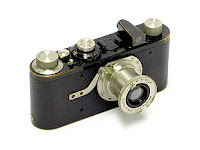Many are familiar with the
development of the Leica by OsKar Barnack which started in 1913 with the
original prototype, the Ur-Leica.
Further development was unfortunately interrupted by WWI, but after
several improvements the decision was made by Ernst Leitz II to build the
camera and production started in 1924.
The camera was officially introduced at the Leipzig spring fair in 1925.
It was not an easy
decision to build the camera. At the
time, Leitz was primarily a microscope manufacturer and branching out into the
manufacture of cameras was seen by many as taking too much of a risk. This was even more emphasized due to the fact
that the Leica presented a huge departure from what was generally considered to
be professional cameras. Many thought
that such a small camera would be incapable of competing with the larger format
professional cameras of the day.
Ur-Leica from 1913 Leica I from 1925
But it was not only the
farsightedness of Ernst Leitz II that led to the production of the Leica, it
was also deeply rooted in the tradition of the company and the Leitz family to offer
the best possible working conditions for their workforce.
Already under Ernst Leitz
I the company began to provide sick leave and health insurance, something quite
uncommon in those days. It was his opinion
that he owed this to his workers which were directly and indirectly the base of
his family’s good fortunes.
Ernsdt Leitz I
This relationship with the
Leitz workforce was carried on by his son, Ernst Leitz II. In 1923 hyperinflation became a huge problem
in Germany. Many companies began laying
off people because business in general dropped to very low levels. This became a problem at Leitz as well. But Ernst Leitz II steadfastly resisted any
layoffs. He felt that he owed his
workers a continued means to make a living.
He thought that the manufacture of the Leica presented the means to be
able to continue to keep his workforce.
Ernst Leitz II
It is this deep sense of
responsibility that a few years later led to what is now often referred to as
the Leitz Freedom Train, a part of the Leitz/Leica history that is relatively
unknown. It was under the Nazi regime in
Germany that Ernst Leitz II began to hire a large number of Jewish people under
the guise of needing their work skills.
He then sent them to various Leitz sales offices throughout the world with
the argument that their skills were needed there. He did this with great risk to himself and
his family, but the result was that the rescue effort of the Leica Freedom
Train resulted in hundreds of Jews to be smuggled out of Nazi Germany by Ernst Leitz II and his daughter Elsie Kühn-Leitz before the Holocaust.
Dr. Elsie Kühn-Leitz was
imprisoned by the Gestapo after she was caught at the border, helping Jewish
women cross into Switzerland. She was
eventually released but had to undergo considerably rough treatment while being
interrogated. She also was questioned
after she attempted to improve the living conditions of 700 to 800 Ukrainian
slave laborers, all of them women, who were assigned to work in the plant
during the 1940s.
Dr. Elsie Kƒhn-Leitz
The Leitz family never sought
any publicity for these efforts with the result that the circumstances of the
Leica Freedom Train did not come to light until recently.
Immediately after the end
of the war, Dr. Elsie Kühn-Leitz continued her public service by promoting education and culture as the Wetzlar
city councilor for Education and Culture among other things. In 1945 she was co-founder of the Wetzlar
cultural community, of which she was chairman for many years. In the culture they saw a way to bring
normalcy in the post-war life.

Wetzlar named a street after Dr. Elsie Kühn Leitz in her honor
In 1954, following a
request from Konrad Adenauer, Germany’s first chancellor after WWII, she began
her decades of commitment to the Franco-German friendship. This included the establishment
of the Franco-German Society in Wetzlar, whose President she was. She also
initiated for Wetzlar to become a sister city with Avignon in 1960. Both
Avignon and Wetzlar thanked her with an honorary citizenship. With remarkable assertiveness, she managed to
overcome prejudices and made a significant contribution to international
understanding. This commitment has been recognized with the highest honors that
could be given by the town of Wetzlar, as well as the Federal Republic of
Germany.
________________________________________________________________________________________
To comment or to read comments please scroll past the ads below.
All ads present items of interest to Leica owners.
To comment or to read comments please scroll past the ads below.
All ads present items of interest to Leica owners.

For rare and collectible cameras go to: http://www.tamarkin.com/leicagallery/upcoming-shows
For rare and collectible cameras go to: http://www.tamarkin.com/leicagallery/upcoming-shows
Click on image to enlarge
Order: info@gmpphoto.com
Click on image to enlarge
Order: info@gmpphoto.com
Click on image to enlarge
Order: info@gmpphoto.com
Click on image to enlarge
Order: info@gmpphoto.com
Please make payment via PayPal to GMP Photography
Click on image to enlarge
Order: info@gmpphoto.com
Please make payment via PayPal to GMP Photography
Click on image to enlarge
Order: info@gmpphoto.com
Please make payment via PayPal to GMP Photography

















No comments:
Post a Comment